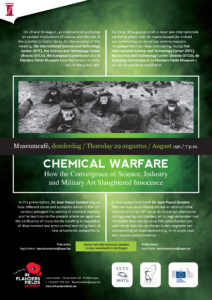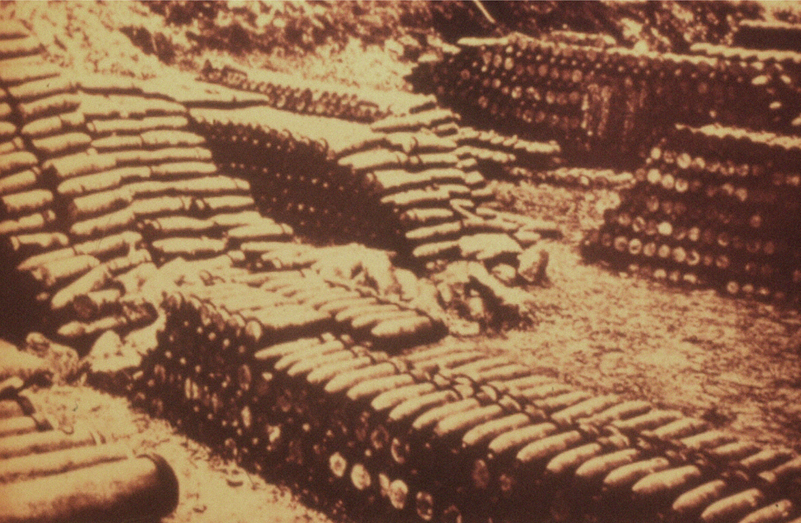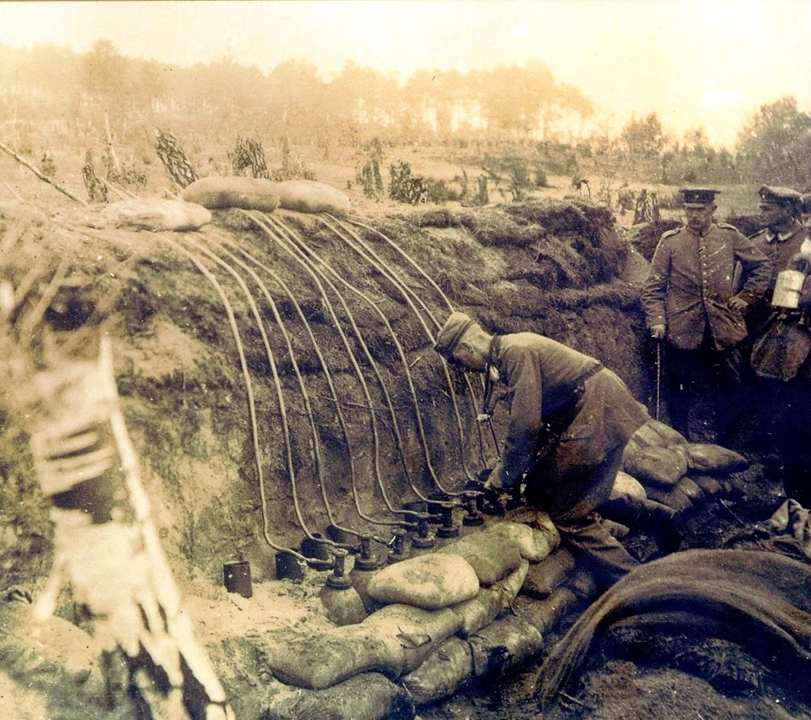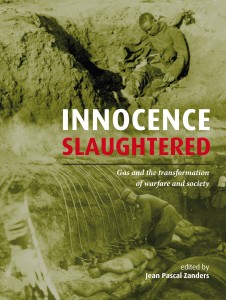How the Convergence of Science, Industry and Military Art Slaughtered Innocence
Keynote speech at the CONDENsE Conference, Ypres, Belgium, 29 August 2019
Good evening ladies and gentlemen, colleagues and friends,
It is a real pleasure to be back in Ieper, Ypres, Ypern or as British Tommies in the trenches used to say over a century ago, Wipers. As the Last Post ceremony at the Menin Gate reminded us yesterday evening, this city suffered heavily during the First World War. Raised to the ground during four years of combat, including three major battles – the first one in the autumn of 1914, which halted the German advance along this stretch of the frontline and marked the beginning of trench warfare; the second one in the spring of 1915, which opened with the release of chlorine as a new weapon of warfare; and the third one starting in the summer of 1917 and lasting almost to the end of the year, which witnessed the first use of mustard agent, aptly named ‘Yperite’ by the French – Ypres was rebuilt and, as you have been able to see to, regain some of its past splendour.
Raised to the ground during four years of combat, including three major battles – the first one in the autumn of 1914, which halted the German advance along this stretch of the frontline and marked the beginning of trench warfare; the second one in the spring of 1915, which opened with the release of chlorine as a new weapon of warfare; and the third one starting in the summer of 1917 and lasting almost to the end of the year, which witnessed the first use of mustard agent, aptly named ‘Yperite’ by the French – Ypres was rebuilt and, as you have been able to see to, regain some of its past splendour.

Modern chemical warfare began, as I have just mentioned, in the First World War. It introduced a new type of weapon that was intended to harm humans through interference with their life processes by exposure to highly toxic substances, poisons. Now, poison use was not new.
However, when the chlorine cloud rose from the German trenches near Langemark (north of Ypres) and rolled towards the Allied positions in the late afternoon of 22 April 1915, the selected poisonous substance does not occur naturally. It was the product of chemistry as a scientific enterprise. Considering that the gas had been CONDENsE-d into a liquid held in steel cylinders testified to what was then an advanced engineering process. Volume counted too. When the German Imperial forces released an estimated 150–168 metric tonnes of chlorine from around 6,000 cylinders, the event was a testimonial to industrial prowess. Poison was not a weapon the military at the start of the 20th century were likely to consider. Quite on the contrary, some well-established norms against their use in war existed. However, in the autumn of 1914 the Allies fought the German Imperial armies to a standstill in several major battles along a frontline that stretched from Nieuwpoort on the Belgian coast to Pfetterhausen – today, Pfetterhouse – where the borders of France, Germany and Switzerland then met just west of Basel. To restore movement to the Western front, the German military explored many options and eventually accepted the proposal put forward by the eminent chemist Fritz Haber to break the Allied lines by means of liquefied chlorine. 22 April 1915 was the day when three individual trends converged: science, industrialisation and military art.
This particular confluence was not by design. For sure, scientists and the military had already been partners for several decades in the development of new types of explosives or ballistics research. And the industry and the military were also no strangers to each other, as naval shipbuilding in Great Britain or artillery design and production in Imperial Germany testified. Yet, these trends were evolutionary, not revolutionary. They gradually incorporated new insights and processes, in the process improving military technology. The chemical weapon, in contrast, took the foot soldier in the trenches by complete surprise. It was to have major social implications and consequences for the conduct of military operations, even if it never became the decisive weapon to end the war that its proponents deeply believed it would.
This afternoon we visited the chemical weapon storage site and destruction facility at Poelkapelle. We saw recovered chemical munitions from the fields around Ypres awaiting destruction. So, if you look at the picture, what do you see?

Well, obviously you see shells from the First World War.
What else do you see? What more does the artefact in the picture tell you?
Indeed, you notice engineering skill, manufacturing skill. And while you cannot actually see it, you know that inside those shells hide a toxic chemical fluid and most likely an explosive charge. In other words, besides engineering and manufacturing, the shell also encompasses the knowledge and skills of chemists. Yet there is even more…

Shells like these were produced in huge quantities. If the First World War had continued into 1919, expectations were that at least one artillery shell in two would have been chemical. So, the technology of a chemical shell also incorporates industrial power. Mass industrial production capacity is as much a critical ingredient of modern chemical warfare as science and technology. These characteristics of a chemical weapon set it apart from any earlier form of poison warfare, which relied on artisanal extraction and preparation of noxious substances from animals, plants or minerals and their application to kinetic weapons. Alternatively, such substances could be burned or introduced into water to contaminate the environment in which humans functioned and survived. Modern chemical ware was something different all together. It made warfare truly three-dimensional. It not only extended the battlefield for kilometres beyond artillery range; the toxic vapours being heavier than air seeped into every hole in the ground, including the dugouts in the trenches. There was no place to run; there was no place to hide. Survival depended on training and chemical defence.
But let us return to the chemical shells in the picture. Deeper down, those shells represent even more than chemistry, engineering and mass production. They reflect a society as a whole. More specifically, they reflect its educational and developmental levels. Here I am not just speaking about the achievements of chemists, engineers and other university-level professionals.
First, the weapon testifies to a society’s overall level of education. When, for instance, German Chancellor Otto von Bismarck introduced universal mandatory education in the early 1870s, he sought to have a disciplined society and work force to support the newly unified country and its military apparatus. He achieved something else too: schooling aided problem solving. With their technology-oriented understanding of the world, young labourers in factories were able to tweak machinery and incrementally improve manufacturing processes. They understood when a problem presented itself and they knew that solutions were possible. They identified the problem, they devised a way to solve it, and then they applied their solution.

And with that we have the definition of ‘technology’. Technology is not just an artefact, a piece of machinery or an object that we can see and touch. It is so much more: it embodies a person’s or a society’s abilities to conceptualise and analyse problems, to find and create solutions, and to effectively deploy those solutions.
Now obviously, a single young person with basic or secondary education is not going to help much with scientific or technical progress. But think of the total workforce in a factory; think of a society thoroughly ingrained with this basic technological mind set. The combined skill levels and expertise will influence progress and lift a nation as a whole to higher levels of complexity and understanding.
A second element promoted the rapprochement between science and industry. And again, Germany was to lead the world. For the greatest part of the 19th century the scientist was essentially an individual, often a person of many interests, who had the time and resources to pursue certain inquiries. If associated with an academic institution, this person was most likely working solitarily in his room or laboratory, nicely writing down the results of experiments, and occasionally making a discovery. Not seldom he would fail to grasp the significance of the discovery and, as a consequence, abandon the line of research. The new product, a chemical compound, for example, remained uncharacterised; its existence merely recorded in passing.
When Germany launched the second phase of the industrial revolution based on organic chemistry, the industry became a driving force in the reorganisation of the scientific enterprise. It hired leading scientists and placed large and well-equipped laboratories at their disposal, or it funded major research institutions. The effects were twofold.
First, the scientist became a member of a team and each member had a specific role to play in research that by now was structured and organised. The evolution also contributed to functional specialisation, such as, for instance, between the chemist and the chemical engineer. Second, research became increasingly applied. It served utilitarian purposes broadly defined by the chemical industry’s needs for innovation and expansion. The teams synthesised many new compounds, characterised them in detail, investigated their potential utility, and, if promising, would set out to explore which methods of synthesis were commercially viable or yielded the highest volumes or best quality.
***
So, in the story so far, we have seen how in the course of the 19th century the practice of science, and chemistry in particular, evolved from a a personal activity by individuals to a highly organised enterprise undertaken by teams under the leadership of an eminent chemist in academic institutions funded by the chemical industry or established within manufacturing plants. This is a first strand of confluence between science and industry.
A second thread was the organisation of universal mandatory education. Its impact was to elevate the overall skill level of all sections in society and introduce a technological mind set geared towards problem identification, problem solving and solution implementation. In this sense, education supported and reinforced the first trend. It produced not just a broader group of highly qualified scientists, engineers and technicians; it also prepared society at large for full integration into the second industrial revolution, which was primarily based on organic chemistry.

Universal mandatory education served a second purpose too: it was geared towards supporting the nation, including its military apparatus. It promoted obedience and thereby fixed people in a hierarchical structure. This was to have major implications concerning ethical consideration, if any, when applying the novel technologies practically.
Through the convergence of science and industry, supported by the broadened educational system, the chemical enterprise became utilitarian, to a certain extent at the expense of fundamental research, in support of expanding economic, and hence national power.
As you may have noticed, the examples have come primarily from Germany, which, as mentioned earlier, is the place where the second industrial revolution took off. It ultimately turned Germany into a global power vying with the British Empire and France for access to resources and markets. By the end of the 19th century Germany owned as good as a global monopoly on synthetic dyes, a product of organic chemistry. Other European countries – even the ones that led during the first industrial revolution based on mechanical power – as well as the United States lagged Germany, not just in terms of manufacturing output, but also with respect to education and the organisation of scientific research.
***
An interesting aspect of chemical warfare in the First World War is the fact that most of the principal agents had been discovered, characterised and industrially produced decades before their first use on the battlefields. During the 16th and 17th centuries chemistry evolved from alchemy into a true science. The first accomplishment that was to influence the nature of warfare in 1915 came towards the end of the 18th century. Chlorine was isolated for the first time around 1630; however little attention was paid to the substance. More than a century and a half later, in 1774, the Swedish pharmacist Carl Wilhelm Scheele described chlorine gas, but believed it was a compound following reaction with an unknown element. Only in 1810 did the British chemist Sir Humphry David determine that chlorine was a pure element.
Sir Humphry David was also the first to synthesise phosgene in 1812. In the second half of the 19th century it would become a major intermediary in the dye industry. Today it still plays a major role in chemical manufacturing. Of all agents used during the First World War, phosgene was responsible for the largest number of chemical warfare fatalities.
Mustard agent, interestingly, has many fathers. In 1822 the Belgian chemist (who later would acquire the French nationality) César-Mansuète Despretz described a process to synthesise mustard agent, however without mentioning its physiological characteristics. The French chemist Alfred Riche repeated the process in 1854, but he too failed to mention the consequences on the body. It would be a British chemist, Frederik Guthrie, who six years later not only synthesised, but also characterised the compound. That same year, the prominent German chemist Albert Niemann, who shortly before had extracted cocaine from coca leaves for the first time, tested the substance on animals and was thus to observe the blistering on the skin. One year later he died of pulmonary suppuration, probably because of exposure to the vapours released by the oily liquid. Another German chemist, Viktor Meyer, published a suitable process to produce mustard agent.
As far as I am aware, mustard agent never had any commercial utility, which might explain why Germany had not thought of using it already in 1915. It is true that medical research in 1919 pointed to reduced white blood cells in mustard agent victims. This insight would ultimately lead to the introduction of a variant of the agent – nitrogen mustard – as a first form of chemotherapy to combat lymphoma and leukaemia. The first human tests took place in December 1942.
***
It is interesting to note that in this brief historical sketch discoveries initially took place in leading countries of the first industrial revolution – Belgium, the British Empire, France – and later developments tended to happen primarily in Germany. The consequences of this shift were visible during the First World War. While the Allies were able to respond fairly quickly (that is, within six months) to the German use of chlorine and even anticipate the use of phosgene in December 1915, it took more than a year after the German introduction of mustard agent near Ypres in July 1917 before they could carry out their own first attack. The Allies never equalled German production capacity (although this could well have happened in 1919 if the war had lasted longer).
Comparing developments in the British Empire and the United States with those in Germany reveals some other differences. Education and industrial organisation in the latter country made progress a collective endeavour. In contrast, in Great Britain, but also in the United States, the scientific and industrial enterprise remained much more individualised.
Especially in the first country, the struggle was different: in order to succeed at the end of the 18th and the beginning of the 19th century, scientists and industrialists had to compete against the traditional society of nobility, the clergy and the so-called third estate. Emerging scientists very often had to undermine ecclesiastical dogmas when proclaiming their hypotheses and theories. Chemistry and biology converged in geology and palaeontology, bringing the Biblical creation narrative into question. Evolutionary biology put Christian doctrines to the test, but conservative resistance was such that Charles Darwin called his most influential work On the Origin of Species, not On the Origin of Life. He thus avoided discussion about the creative process itself. At the same time, scientists also had to undermine privileged aristocracy to have an impact on political policies with their research results. For themselves and for their community, they had to gain in social influence that far exceeded that of the third estate. The same applied to the entrepreneurs. By the end of the 19th century they had almost succeeded. But the convergence between and integration of science and industry (which was still largely based on the achievements of the first industrial revolution) happened only slightly and progressed slowly. That struggle had yet another consequence: the particularly positivistic nature of science in those countries; a force for the good; a view that ignored negative consequences.
***
The last element in my story this evening concerns the convergence of science and industry, on the one hand, and military art, on the other hand. So, let us return to that fateful Thursday afternoon of 22 April 1915. The yellow-green chlorine cloud that drifted from the German trenches to the Franco-Algerian positions left a gap of several kilometres in the Allied lines, a result that completely surprised the attackers. The first large-scale use of chemical weapons was an experiment. Chemical warfare was not integrated into German military doctrine, and therefore no guidelines existed on how to use chemical weapons in strategic and tactical situations. The German planners did not foresee troops or undertook logistical planning to exploit the outcome of the first use of a new type of weapon. After all, the road to the French Channel ports lay completely open. After a few months of heavy, bloody fighting, the bow around Ypres had narrowed somewhat. But never again in the history of warfare would chemical weapons provide such a strategic advantage that they could have determined the outcome of a conflict.
Often during the First World War the various armed forces deployed new types of agents, hoping to be able to turn the tide definitively, but the weapons soon became a tool of attrition. The explanation was and is fairly simple: primary protection against toxic agents only requires the placement of a physical barrier between the agent and the human body. Handkerchiefs soaked in urine for the nose and mouth during the Second Battle of Ypres; later the gas masks and protective suits. The race between the offensive and defensive aspects of chemical warfare had begun, and except for a few short breaks, the defence has always prevailed or been able to significantly lower any potential benefit of resorting to chemical weapons. After 1918 this elementary fact considerably reduced the offensive utility of chemical weapons; their further development and possession politicians and the military would mainly rationalise based on a deterrence strategy.
As I have already indicated, the strategic failure of the chlorine attack was closely linked to the experimental nature of the first large-scale deployment of the chemical weapon. In other words, the attack was not the product of lengthy military and logistical planning. Rather it resulted from a feverish search for a technological solution to break the deadlock on the Western front. After all, the German von Schlieffen Plan called for maximal mobility to rapidly go around the French army via Belgium. Greater Belgian resistance than expected and the First Battle of Ypres in the autumn of 1914 frustrated German ambitions. Berlin realised all too well that Germany could not sustain a war of attrition for too long, certainly not on fronts both in the west and east, and even less after the Allies imposed a naval blockade against the empire.

The decision to use chlorine was opportunistic in various respects, and probably logical from the perspective of a highly industrialised and scientific-technological society. Part of the German chemical industry suffered from overcapacity because of the blockade. Chlorine was available in relatively large quantities and there were sufficient numbers of steel gas bottles to transport the liquefied gas. In addition, no new type of ammunition had to be developed and tested: internal pressure sufficed to force the compressed chlorine out of the cylinders. Numerous chemists had already joined the military; one of them – Fritz Haber – had enough influence in the right places to let the experiment proceed. And there was enough frustration among the military about the stalemate to reluctantly try something new.
***
So, to summarise, at the start of the 19th century, three major, independent trends slowly began to reshape societies in the west of Europe and North America and, as they began to accelerate and intensify, forged new power relationships among emerging nation-states. These were the rise of chemistry as a primary science; the second industrial revolution based on commercial application of organic chemistry; and the progressive mechanisation of warfare with its incorporation of technological applications into weapon design and production. Ultimately, modern chemical warfare resulted from the convergence of science, industrialisation and military art forced by circumstances.
Less than two decades after the Armistice in 1918, German scientists researching new types of insecticides came across a very powerful toxic substance. The difference with the 19th century was that they immediately realised the potential military value of their chance discovery and they informed the military authorities accordingly. Thus the first generation of nerve agents came into being. With the quest for the atomic bomb in the Manhattan Project, in contrast, such convergence was deliberately pursued. Today, pursuing convergence between different scientific, technological and societal trends are a core characteristic of weapon development.
Science and technology have lost their innocence. Any progress is systematically being scanned for potential military utility. New convergences create new enabling platforms, which in turn lay the foundation for new advances whose impact and consequences we cannot always foresee today. What appears single-use today, may be dual-use tomorrow. What appears beneficial today, may destroy the environment or prove harmful tomorrow.
The prevention of the transfer of scientific and technological progress for malicious purposes is a fundamental challenge that we try to address through the CONDENsE series of conferences. Thank you.
***
Innocence Slaughtered: Gas and the transformation of warfare and society (Uniform Press: London, 2016)

